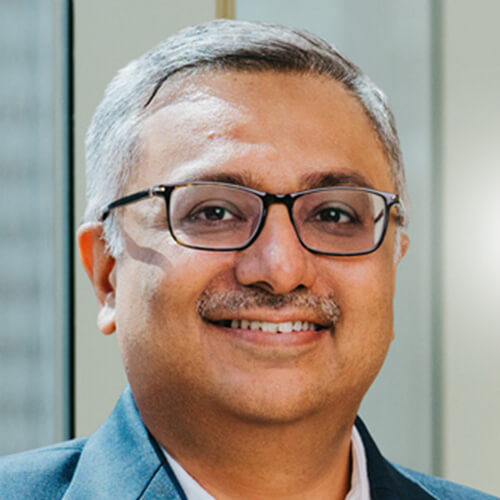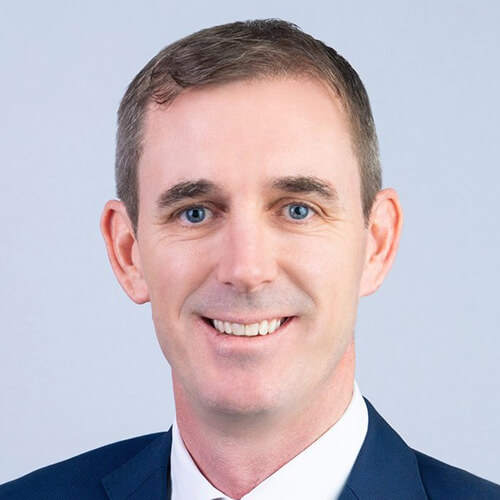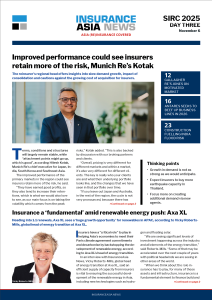SIRC: Reinsurers look to consolidate underwriting gains while tapping into fast-growing APAC
November 11 2024 by Mithun Varkey
The Singapore International Reinsurance Conference (SIRC) in the first week of November was a true testament to the Lion City’s rise as a truly global (re)insurance hub and the event itself becoming a premier international industry event that cannot be ignored.
The 20th edition of the conference saw record participation topping 3,300 people, a 20% increase on last year’s numbers, which was then a record.
This year’s event also saw the passing of the mantle at the Singapore Reinsurers’ Association (SRA), the organisers of the event. Allianz Re’s Kenrick Law takes over as the chairman of SRA from Marc Haushofer, who has been in the role for eight years. Law is joined by James Beedle, PartnerRe APA CEO, as deputy chairman.
In a break from the past two years’ editions, discussions at the SIRC were, for the want of another word, “uneventful”, which the reinsurers will be quick to point out is how they like it. Or as a reinsurer’s CEO put it, “boring is better”.
Growth is certainly on everybody’s agenda. Asia Pacific offers the growth opportunities that the reinsurers are looking for given the economic prospects and exposure growth, however, it is a double-edged sword that could also lead to an erosion of reinsurers’ hard-earned underwriting gains.
While the pains of the hard market and the structural adjustments seen in the past couple of renewals are behind us, there were a few themes that rang out clear and loud.
The InsuranceAsia News team’s exhaustive coverage from the event has already brought them to you, but here are the major takeaways from the renewals gathering that we believe will set the mood for the coming year and the renewals.

“I think that we are returning to a more orderly round of discussions. There is less heat in the market, because everybody is used to stronger renewals and a stronger reinsurance market, at least since last year. And I think that there are good reasons that it prevails and will be less stressful.”
Franz-Josef Hahn, Peak Re
Stable renewals
The consensus is that we are back to stable and orderly renewals. Having been through a few iterations of renewal discussions that went to the wire, there is a sense of calm about the upcoming renewal seasons.
The reinsurers, brokers and cedents seem to have found their balance and they expect it to continue.
Munich Re believes it should “maintain that balance the market has currently found”, Hitesh Kotak, chief executive in charge of the reinsurer’s P&C business in Japan, India, Korea and South-East Asia told InsuranceAsia News.
“Terms and conditions and structures are likely to remain stable because most of the wordings and the issues on structures were taken care of in the last couple of years,” he said.
Peak Re’s Franz-Josef Hahn said: “I think that we are returning to a more orderly round of discussions. There is less heat in the market, because everybody is used to stronger renewals and a stronger reinsurance market, at least since last year. And I think that there are good reasons that it prevails and will be less stressful.”
However, there are some concerns around growing losses from non-peak perils across Asia.
Reinsurers are “still guarding themselves to not let loose”, noted Hahn.
While reinsurers are clear they are not willing to go any lower into their programs and claim that cedents are getting comfortable, and even “happy” with increased underwriting responsibility, brokers will tell you off the record that their clients would like to see some covers that protect against attritional losses.
Even then, cedents’ expectations are modest and they are aware of the fact that there will not be a quick return to “good” old days.

“Terms and conditions and structures are likely to remain stable because most of the wordings and the issues on structures were taken care of in the last couple of years.”
Hitesh Kota, Munich Re
Bespoke solutions
An emerging theme among reinsurers is the rise of structured solutions and the demand for capital advisory offerings.
Large reinsurance brokers in the region have been building out their teams in the past year and reinsurers are more willing to deploy capital for such programs.
The rise in the demand for creative reinsurance solutions is driven by a need to reduce volatility because traditional reinsurance has been shying away from attritional losses and aggregate covers and to address changing capital regimes and regulatory developments.
As the operating environment becomes more complex and tensions arise across various stakeholders, advisory engagements and bespoke solutions will become more frequent, Guy Carpenter’s Justin Ward told IAN.
“Volatility remains omnipresent for many of our clients as the nature of risk changes, insured values grow, retentions are raised and the cost of risk transfer escalates,” according to Ward.
“We’ve completed around 70 structured deals, most of which are focused on the bottom end of clients’ excess of loss programmes, so we don’t see any change to that,” said Mark O’Brien, Gallagher Re’s APAC head.

“The appetite to deploy capacity for structured deals by the market has certainly increased during the hard market, so clients have more choice now, and I expect that to continue.”
Mark O'Brien, Gallagher Re
Reinsurers are also increasingly looking to cater to the demand. Whilst previously, structured deals were the preserve of large players such as Swiss Re, Munich Re and Hannover Re. Market participants say that more and more capacity providers are willing to deploy capital in the space.
“The appetite to deploy capacity [for structured deals] by the market has certainly increased during the hard market, so clients have more choice now, and I expect that to continue,” said O’Brien.
Peak Re’s Hahn said demand for “structured solutions is still very much in vogue… specifically here in Asia Pacific, whether emerging or developed markets, driven by regulatory changes”.
“There are requirements by direct or primary companies to find alternatives to equity investments and structured solutions are definitely the right way,” he said.
Specialty shift
At the SRIC, this year, there seemed to be a lot more buzz around specialty products and the growing demand from the region, which is certainly helped by the increasing need for cyber and renewable energy capacity.
There is demand for specialty products with Asia’s growing clout as the manufacturing hub of the world, especially with the rise of markets outside China such as Malaysia, Vietnam and India.
Demand in the region is driven by general infrastructure developments, said Anne Lohbeck, Swiss Re’s chief underwriting officer specialty. “There are also specific infrastructure developments in energy provisioning and green energy transition that will largely fall into the engineering and construction markets, some of that also falling into marine depending on how the risks are suited.”

“There are also specific infrastructure developments in energy provisioning and green energy transition that will largely fall into the engineering and construction markets, some of that also falling into marine depending on how the risks are suited.”
Anne Lohbeck, Swiss Re
An emerging line of business in a number of geographies across APAC is inherent defect insurance, which is a sub-segment of engineering and construction becoming compulsory, according to Lohbeck.
Other emerging lines such as cyber, credit and surety, accident and health were flagged as key market drivers.
The Indian market is very much a key driver for growth in the region given the scale of infrastructure development and manafucturing growth in the market. The government’s push for more surety cover for its infrastructure projects was certainly a hot topic of discussion, though the product is still being finetuned.
Structural changes
There is growing consensus among insurers for the need to shift more and more programs in the region to excess of loss treaties.
CEOs of all the large players in the region have said they would like to see the market shift away from pro-rata treaties.
While certain markets like the Philippines have already been through the shift and so did Thailand following the 2011 floods, many hope that the losses from Typhoon Yagi, which is set to hit reinsurers hard given that local retentions on these programs are only 10-15%, will drive a shift in Vietnam in this round of renewals. Many think that markets like Indonesia, with its regulatory changes, could also see some transition.
However, the bigger market in the region such as China and India continue to heavily favour proportional structure.
“We support and encourage the trend of shifting from proportional to non-proportional treaty structures to the larger insurance companies who have built the underwriting capabilities and the right tools to manage their exposures,” said Munich Re’s Kotak.
“We advise our clients to tackle this actively in calm waters instead of waiting for a large event to trigger the change,” he added.

“Insurance has often been viewed as slow to change and as a result, has not always been the first career choice among students and fresh graduates. This needs to change if we’re to futureproof our industry.”
Soon Keen Lee, Canopius
Attracting talent
The biggest challenge for the broader (re)insurance sector seemed to be finding the right talent.
As Soon Keen Lee, Canopius’s CEO for APAC and MENA, noted it the specialty (re)insurer’s recent talent report, “Insurance has often been viewed as slow to change and as a result, has not always been the first career choice among students and fresh graduates. This needs to change if we’re to futureproof our industry. The next wave of retirements will soon be upon us, and as more seasoned professionals exit our industry, we’ll be left with a huge gap to fill.”
A notable statistic from the report was that about 28% of young Singaporean graduates did not see insurance as an attractive career path. And interesting, the more than a quarter of those who don’t seem enticed by an insurance career noted that limited career growth opportunities, a lack of information about what the industry has to offer and a perception that the industry is
boring as the main reasons why they don’t want to join the industry.
Insurers sure need to do more to counter the negative perception that is putting the youth away from the industry.
What is true for Singapore is also true for nearly all other markets in the region. Insurers have to compete not only with other financial services and consulting companies but also with tech and other emerging industries.
In Singapore, all insurers and reinsurers either already have or are considering graduate programmes to attract young talent. While it is a step in the right path, much more needs to be done.
-
Space race creates need for insurers to launch new approach to risk
- November 3
Insurers are concerned by the ‘run, fail, fix it’ approach adopted by the new breed of space companies.
-
SOS: insurers fear Net-Zero Framework delay will send decarbonisation progress off course
- October 31
International Maritime Organization's framework was approved in April and was expected to be formally adopted at a special meeting in London earlier this month.
-
Cargo insurers brace for distortion of established shipping patterns amid US-China trade war
- October 28
Recent escalation following Chinese port fees could bring volatility, accumulation risks, political as well as contractual uncertainty and require commercial adjustments, underwriters say.
-
Russian stranded assets now viewed as US$10bn market loss
- October 27
The bulk of the loss is also likely to be absorbed not by the aviation war market, as originally thought, but actually by the marine market.
-
Beazley | What does cyber protection look like from day 1 to day 600 and beyond?
Cybersecurity is no longer just an IT concern, but a governance issue that belongs on the boardroom agenda.
-
Sedgwick | Preparing for the next storm
Insurance industry needs to recalibrate, invest in innovation and strengthen systems, talent and data practices.
-
Peak Re | From climate modelling to market opportunity: Forging a new clarity on Southeast Asia’s climate risk
Southeast Asia's protection gap: a crisis of clarity, not just capital
-
BHSI WICare+ | Accelerating Payments, Empowering Recovery
Launched in cooperation with Steadfast’s Singapore network, WICare+ fills the gaps found in traditional coverage and keeps businesses and their workforce secure by covering up to SG$350,000 in medical expenses per claim.

